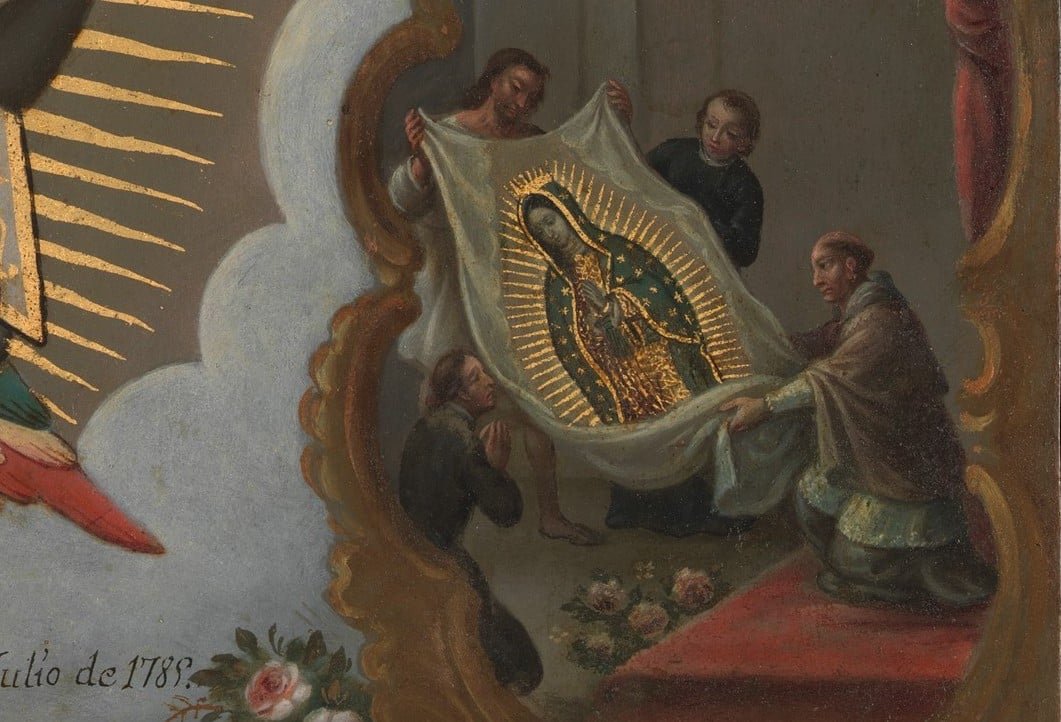Ten years after Hernando Cortez had conquered Mexico City, and long before the settlements in Jamestown the first recorded apparition in America was documented by the Indigenous writer Antonio Valeriano. Valeriano’s document, published in 1649, is featured in “El Nican Mopohua” and was written in Nahuatl, the language of the Aztecs or Mexicano’s.
The story tells of the apparitions of Juan Diego Cuāuhtlahtoātzin, also known simply as Juan Diego. On December 9, 1531, Juan Diego, a Nahua peasant and devout Catholic, was on his way to Mass near the Franciscan mission station at Tlatelolco. As he passed the hill of Tepeyac which is near Mexico City he began to hear beautiful melodies, and he saw a lovely lady who called out his name. She spoke in his native tongue, and he asked the Blessed Mother her name. She responded, “Tlecuatlecupe” which means “the one who crushes the head of the serpent” The serpent was the prominent symbol of the Aztec religion which performed human sacrifices. When pronounced correctly, “Tlecuatlecupe” bears a striking resemblance in sound to “Guadalupe.”
As Juan Diego approached, she said in the Aztec language, “Know for certain, least of my sons, that I am the perfect and perpetual Virgin Mary, Mother of Jesus, the true God, through whom everything lives, the Lord of all things near and far, the Master of Heaven and earth. It is my earnest wish that a temple be built here to my honor. Here I will demonstrate, I will manifest, I will give all my love, my compassion, my help and my protection to the people. I am your merciful mother, the merciful mother of all of you who live united in this land, and of all mankind, of all those who love me, of those who cry to me, of those who seek me, and of those who have confidence in me. Here I will hear their weeping, their sorrow, and will remedy and alleviate all their multiple sufferings, necessities, and misfortunes.”
She instructed Juan Diego to inform Bishop Zumarraga about her wish for a church to be erected on that site. Bishop Zumarraga, after hearing Juan Diego’s account, patiently indicated he would consider it, naturally expressing skepticism about the tale.
Juan Diego returned to Tepayac and relayed the bishop’s response. Mary encouraged him to persist. The following day, he approached the bishop again. Despite greater difficulty in gaining an audience, Juan Diego succeeded, and the bishop listened with patience. Yet, the bishop requested a sign from Mary to verify the account. Juan Diego conveyed this to the Blessed Mother, who assured him that he would be given “the sign” for the bishop the next day.
On December 11, Juan Diego devoted his day to taking care of his gravely ill uncle, Juan Bernardino. His uncle requested that Juan Diego bring a priest to hear his confession and give him the last rites. The following day on December 12, Juan Diego embarked once more but took a different route to avoid Tepeyac Hill, feeling ashamed for not having fulfilled the Blessed Mother’s request to return the day before.
As he took this detour, he was stopped by the Blessed Mother and she said to him, “Hear and let it penetrate into your heart, my dear little son: let nothing discourage you, nothing depress you. Let nothing alter your heart or your countenance. Also, do not fear any illness or vexation, anxiety or pain. Am I not here who am your mother? Are you not under my shadow and protection? Am I not your fountain of life? Are you not in the folds of my mantle, in the crossing of my arms? Is there anything else that you need?” Mary reassured Juan Diego that his uncle would not die; in fact, his health had been restored.
Mary then instructed Juan Diego to go to the mountain and gather flowers. He climbed the hill, which was arid and barren, a place for cacti, and discovered roses like those from Castille, yet not native to Mexico. He gathered them in his tilma, a garment like a poncho. He brought them to Mary who arranged them and said to take them to the bishop.
Juan Diego returned to the residence of Bishop Zumarraga. After awaiting his turn, he conveyed the message once more to the bishop and unfolded his tilma to reveal the roses. To the bishop’s astonishment, he saw not just the splendid flowers but also the miraculous image of Our Lady of Guadalupe. Overcome with emotion, Bishop Zumarraga shed tears at the vision of the Holy Mother and sought pardon for his skepticism.
Bishop Zumarraga placed the tilma at the altar in his chapel. By that Christmas, a humble adobe structure had been erected on Tepeyac Hill to honor Our Blessed Mother, Our Lady of Guadalupe. It was dedicated on December 26, 1531, on the feast day of St. Stephen the Martyr.





We would be happy to provide you with any advertising needs. Our full-page ad is $200 and runs continuously for 3 months. Please let me know if you would like a particular location you would like to target. 3.5K to 100K coverage